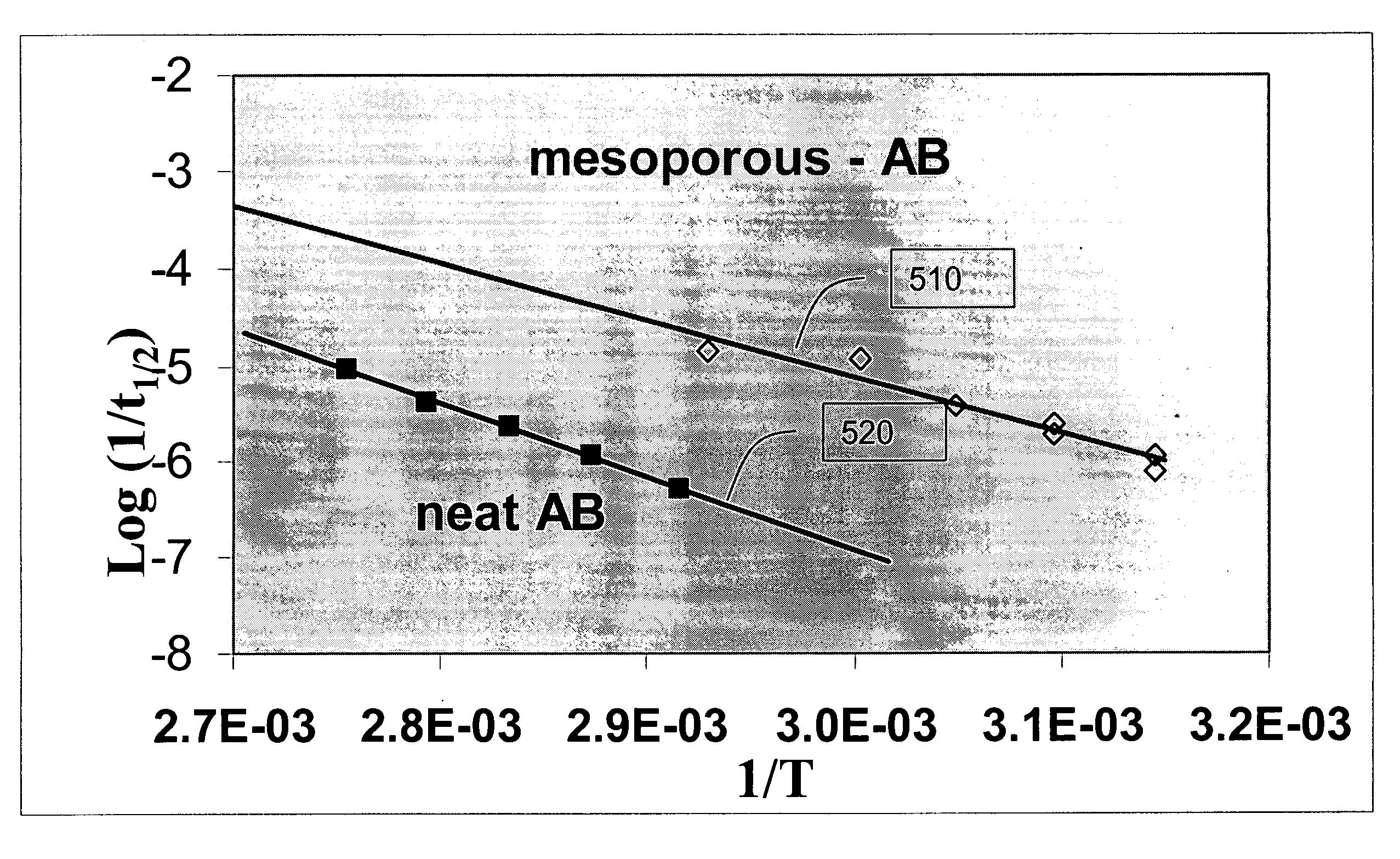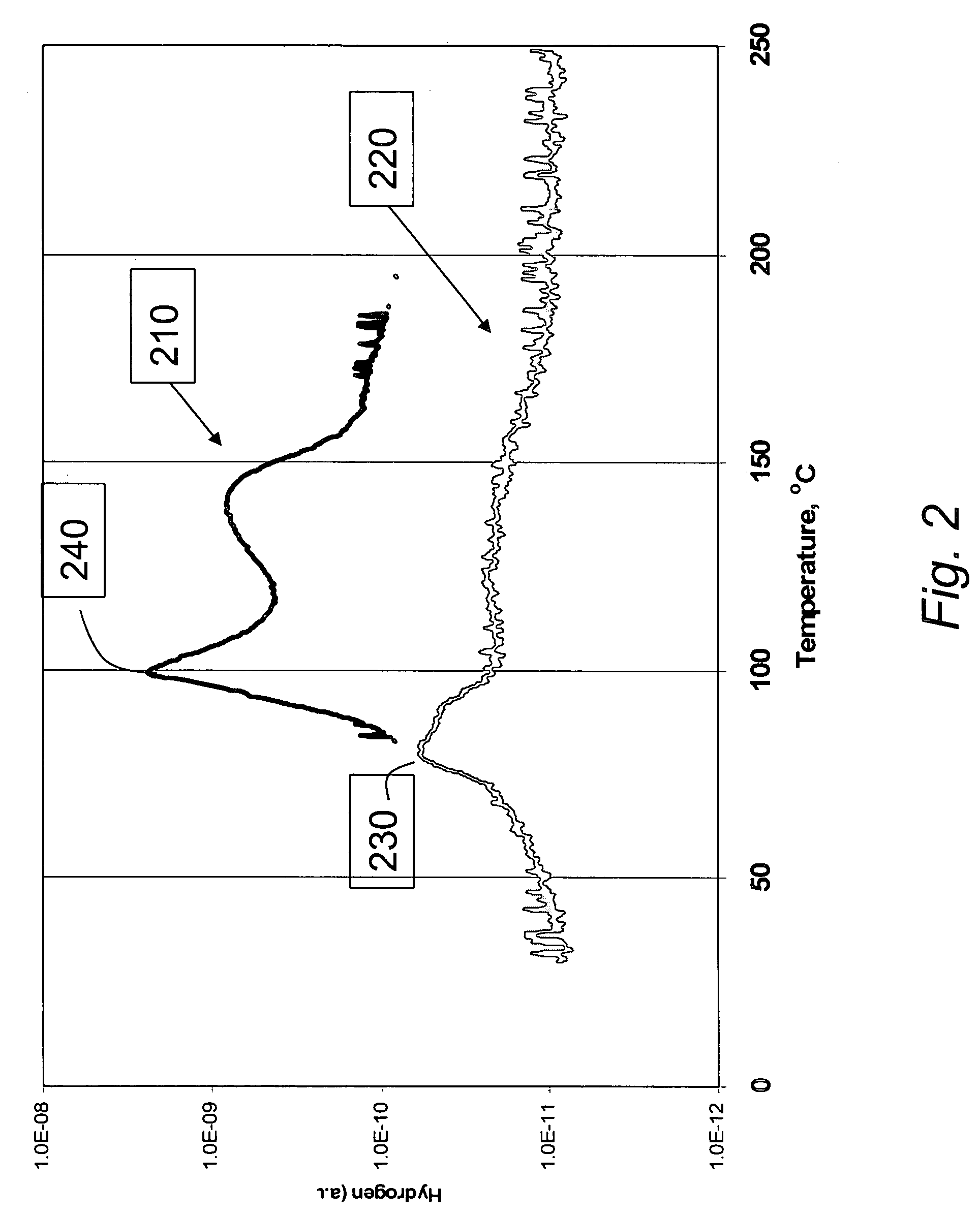Materials for storage and release of hydrogen and methods for preparing and using same
a technology of hydrogen and materials, applied in the field of materials and processes for storing hydrogen, can solve the problems of reducing the purity of released hydrogen available as fuel, affecting the efficiency of fuel cells, so as to improve the hydrogen release rate, reduce the temperature, and control the effect of reactivity
- Summary
- Abstract
- Description
- Claims
- Application Information
AI Technical Summary
Benefits of technology
Problems solved by technology
Method used
Image
Examples
example 1
[0036]In a first embodiment of the present invention, hydrogen release temperatures for a 1:1 AB:SBA-15 composite were compared to release for the neat and / or bulk AB material.
[0037]Experimental. A support 100, SBA-15, comprising mesoporous silica with a plurality of hexagonally ordered nanoscale pore channels was prepared as described by Zhao et al., incorporated in its entirety herein. In a typical preparation of SBA-15, 12.0 g of non-ionic surfactant comprising ethylene oxide / propylene oxide block copolymer (MW=approx. 5,800) sold commercially under the trade name Pluronic® P-123 non-ionic surfactant (BASF Corp., Mount Olive, N.J.) was dissolved in 360 mL of 2M HCl solution at 40° C. 25.5 g of 98% tetra-ethyl-ortho-silicate (TEOS), available commercially (Sigma-Aldrich Corp., St. Louis, Mo.), was added to the milky solution and stirred for 18 hours at the same temperature. The mixture was transferred into a teflon-lined autoclave and heated to 100° C. for 24 hours without stirrin...
example 2
[0042]In a second embodiment of the present invention, AB:SBA-15 composites at weight ratios greater than 1:1 were used to compare hydrogen yields to the neat or bulk AB material. Expectation was that the hydrogen release temperatures would be reduced compared to the bulk material.
[0043]Experimental. Composite materials were prepared as in Example 1 at weight ratios for AB to SBA-15 of 2:1 and 3:1 and compared to results for both the 1:1 composite and the neat AB material.
[0044]Results. FIG. 3 presents results comparing mass-spectral (MS) data for hydrogen release as a function of DSC thermal decomposition temperature for a 2:1 AB:SBA-15 composite 320 material and a 3:1 AB:SBA-15 composite 330 material relative to the 1:1 AB:SBA-15 composite 310 and neat. AB 320. In the figure, maximum exotherm temperatures for hydrogen release in the 2:1 composite 320 and the 3:1 composite 330 were 89.9° C. and 92.7° C., respectively. These compare with a release temperature for the 1:1 composite 3...
example 3
[0045]n order to achieve peak fuel performance, the cyclization reaction that forms borazine (FW=80.47), illustrated in reaction (8), must be minimized and the desired dehydrogenation reactions shown in reactions (6) and (7) optimized. Samples of the 1:1 AB:SBA-15 test material were used to test the hypothesis that the yield of borazine would be reduced in the 1:1 AB:SBA-15 test material when heated, compared to the neat or bulk AB material. If, as expected, the AB was coated on the inside of the mesoporous silica (e.g., SBA-15) template 100, the expectation was that the template 100 would minimize borazine formation by controlling linear polymer growth and minimizing the undesired cyclization reaction.
[0046]Experimental. Differential scanning calorimetry (DSC) experiments were conducted with concurrent collection of mass-spectral (MS) data to compare samples of neat AB material to test samples of 1:1 AB:SBA-15 material prepared as in Example 1. DSC scan temperature was from 20-200°...
PUM
| Property | Measurement | Unit |
|---|---|---|
| temperature | aaaaa | aaaaa |
| temperature | aaaaa | aaaaa |
| size | aaaaa | aaaaa |
Abstract
Description
Claims
Application Information
 Login to View More
Login to View More - R&D
- Intellectual Property
- Life Sciences
- Materials
- Tech Scout
- Unparalleled Data Quality
- Higher Quality Content
- 60% Fewer Hallucinations
Browse by: Latest US Patents, China's latest patents, Technical Efficacy Thesaurus, Application Domain, Technology Topic, Popular Technical Reports.
© 2025 PatSnap. All rights reserved.Legal|Privacy policy|Modern Slavery Act Transparency Statement|Sitemap|About US| Contact US: help@patsnap.com



